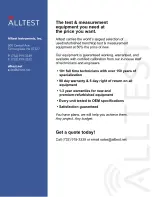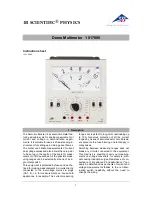
35
• If you have questions which remain unanswered by these operating instructions, contact our technical
support service or other technical personnel.
b) Batteries / Rechargeable batteries
• Ensure that you insert the battery in the correct polarity.
• To prevent battery leakage, remove the battery when you do not plan to use the product for an extended
period. Leaking or damaged batteries may cause acid burns if they come into contact with your skin.
Always use suitable protective gloves when handling damaged batteries.
• Batteries must be kept out of the reach of children. Do not leave batteries lying around, as there is a risk
that children or pets may swallow them.
•
Batteries must not be dismantled, short-circuited or thrown into fire. Never recharge non-rechargeable
batteries, as this may cause an explosion.
c) Persons and product
• Do not use the device if the rear cover is not closed. This may pose a hazard of electrical shock.
• Check the meter and its test leads for damage before each measurement.
• Do not use the device if the device or test leads appear damaged or if you suspect that the device is
not operating properly. Pay particular attention to the insulation. Never carry out any measurements if
the protecting insulation is defective (torn, ripped off etc.). Replace the test lead if the insulation layer
is damaged.
• Never operate the product in direct proximity of:
-
strong magnetic or electromagnetic fields
- Transmitter aerials or HF generators.
This could affect the measurement.
• The rotary switch should be switched to proper position for measuring.
•
Only use measuring leads that conform to the specifications for the multimeter when measuring.
• The voltage between the connection points of the meter and earth potential must not exceed 600 V DC/
AC in CAT III.
• Check the meter and its measuring lines for damage before each measurement. Never carry out any
measurements if the protecting insulation is defective (torn, ripped off etc.).
• Do not change the internal circuit of the device in order to avoid the damage to the device and users.
• The measuring prods have to be removed from the object measured every time the measuring range
is changed.
• The voltage between the connection points of the meter and the earth potential must not exceed 600 V
(DC/AC) in CAT III.
• Be especially careful when dealing with voltages higher than 25 V alternating (AC) or 35 V direct voltage
(DC)! Even at these voltages it is possible to receive a potentially fatal electric shock if you touch
electrical conductors.
• To avoid electric shock, make sure not to touch the connections/measuring points to be measured
directly or indirectly during measurement.
















































